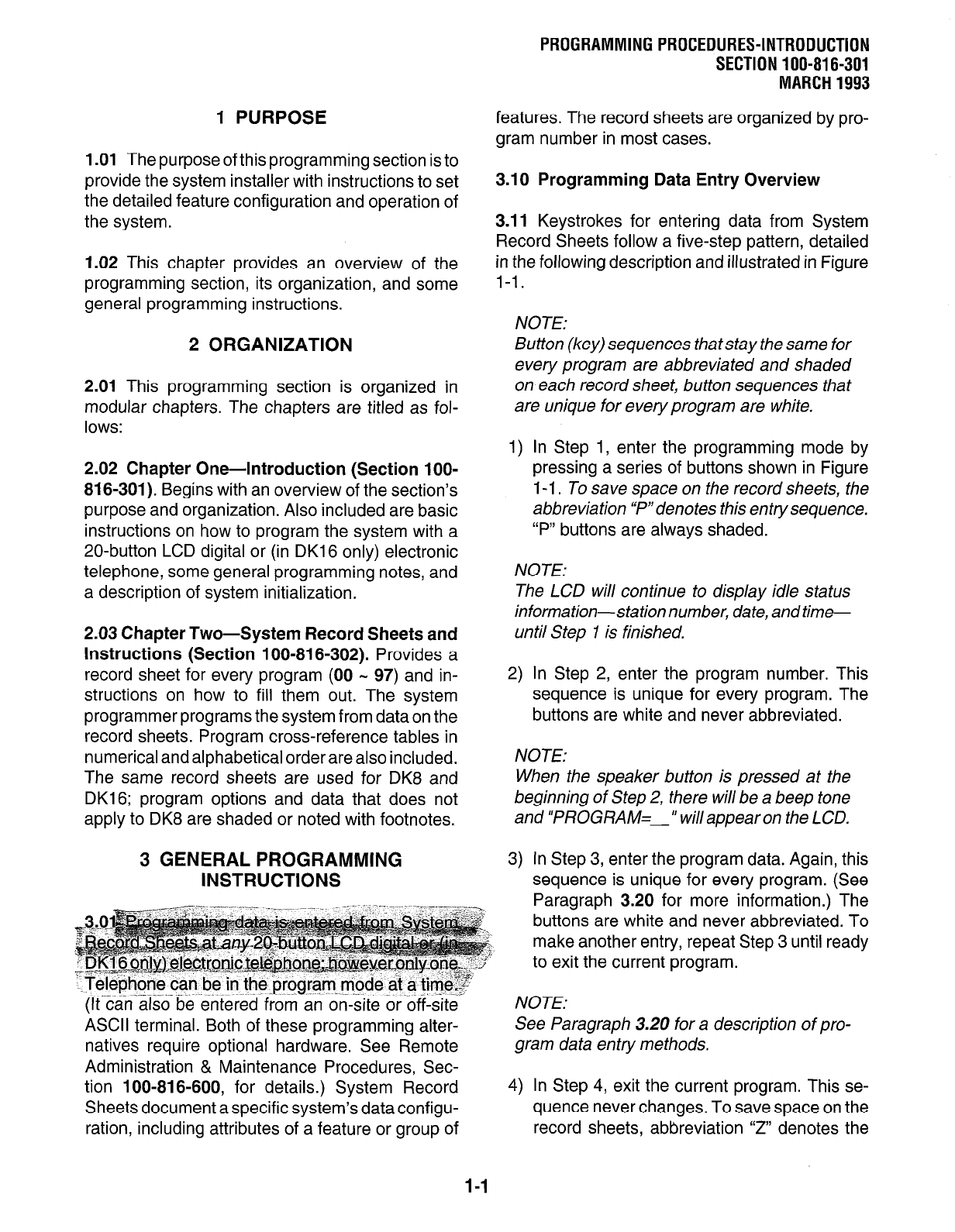
PROGRAMMING PROCEDURES-INTRODUCTION
SECTION 100-816-301
MARCH 1993
1 PURPOSE
1 .Ol
The purpose of this programming section is to
provide the system installer with instructions to set
the detailed feature configuration and operation of
the system.
1.02
This chapter provides an overview of the
programming section, its organization, and some
general programming instructions.
2 ORGANIZATION
2.01 This programming section is organized in
modular chapters. The chapters are titled as fol-
lows:
2.02 Chapter One-Introduction (Section lOO-
816-301).
Begins with an overview of the section’s
purpose and organization. Also included are basic
instructions on how to program the system with a
20-button LCD digital or (in DK16 only) electronic
telephone, some general programming notes, and
a description of system initialization.
2.03 Chapter Two-System Record Sheets and
Instructions (Section
100-816-302). Provides a
record sheet for every program (00 N 97) and in-
structions on how to fill them out. The system
programmer programs the system from data on the
record sheets. Program cross-reference tables in
numerical and alphabetical order are also included.
The same record sheets are used for DK8 and
DK16; program options and data that does not
apply to DK8 are shaded or noted with footnotes.
features. The record sheets are organized by pro-
gram number in most cases.
3.10 Programming Data Entry Overview
3.11
Keystrokes for entering data from System
Record Sheets follow a five-step pattern, detailed
in the following description and illustrated in Figure
l-l.
NOTE:
Button (key) sequences that stay the same for
every program are abbreviated and shaded
on each record sheet, button sequences that
are unique for every program are white.
1) In Step 1, enter the programming mode by
pressing a series of buttons shown in Figure
l-1. To save space on the record sheets, the
abbreviation “P” denotes this entry sequence.
“P” buttons are always shaded.
NOTE:
The LCD will continue to display idle status
information-station number, date, and time-
until Step 1 is finished.
3 GENERAL PROGRAMMING
INSTRUCTIONS
(It can also be entered from an on-site or off-site
ASCII terminal. Both of these programming alter-
natives require optional hardware. See Remote
Administration & Maintenance Procedures, Sec-
tion
100-816-600,
for details.) System Record
Sheets document a specific system’s data configu-
ration, including attributes of a feature or group of
2) In Step 2, enter the program number. This
sequence is unique for every program. The
buttons are white and never abbreviated.
NOTE:
When the speaker button is pressed at the
beginning of Step 2, there will be a beep tone
and “PROGRAM=-’ will appear on the LCD.
3) In Step 3, enter the program data. Again, this
sequence is unique for every program. (See
Paragraph 3.20 for more information.) The
buttons are white and never abbreviated. To
make another entry, repeat Step 3 until ready
to exit the current program.
NOTE:
See Paragraph 3.20 for a description of pro-
gram data entry methods.
4) In Step 4, exit the current program. This se-
quence never changes. To save space on the
record sheets, abbreviation “Z” denotes the
l-l
